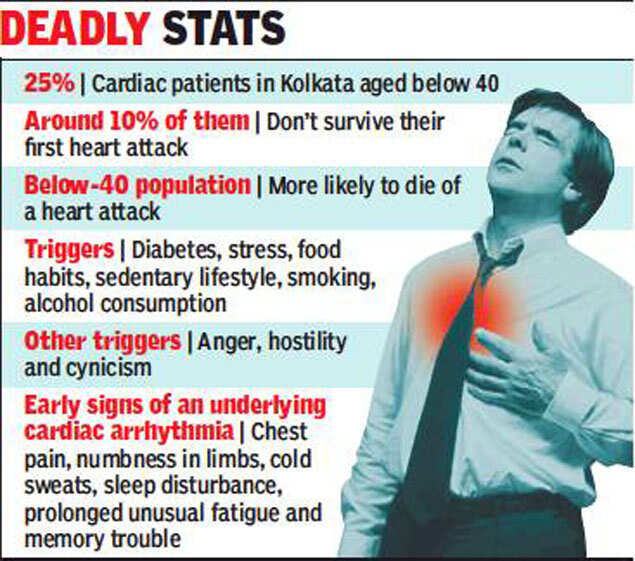
KOLKATA: Around a fourth of the city’s heart patients is now aged below 40 and nearly 10% of them don’t survive their first heart attack, often due to late intervention, according to senior cardiologists. It still takes around 60 to 90 minutes for a heart-attack patient to be transferred to a cathlab table for a life-saving primary angioplasty at the city’s private hospitals. Experts felt that more lives can be saved if this time is reduced.
At BM Birla Heart Research Centre — which celebrated its 30th anniversary on Monday — a process has been activated to reduce the ‘door-to-balloon time’ or the time taken to open a cardiac patient’s blocked artery from the moment of arrival. Around 90% of heart-attack patients seeking treatment at the hospital are now treated at the cathlab within 40 minutes.

“We have multiple teams to expedite the process of treatment once a cardiac patient reaches our doorstep. From the managers at the desk to the lift operator, barber, nurses and doctors, everyone makes sure that the patient’s family doesn’t have to stand in queue for the admission formalities. The moment it is decided that a patient needs angioplasty, we activate the code ‘heart attack’ and everyone involved in the process makes sure that not a second is wasted,” said interventional cardiologist at BM Birla Anjan Siotia.
It is now possible to carry out a primary angioplasty within half-an-hour of the patient being brought in, said Medica Superspecialty Hospital’s head of cardiac surgery Kunal Sarkar. “Most private hospitals have the infrastructure and the personnel to do it. It is indeed a life-saver,” he said.
AMRI Hospitals, one of the first to introduce primary angioplasty in the city, claimed that its ‘door-to-balloon’ time is 70-75 minutes. “According to US guidelines, it should be less than 90 minutes. We have managed to bring it down to 70. But often, a lot of time is wasted since patients’ families have to be convinced about the necessity of the procedure,” said AMRI Hospital’s head of department of cardiology P K Hazra.
Along with dietary habits, diabetes and smoking, stress has emerged as the leading cause of heart attack, especially among the youth. We have at least a couple of patients in their twenties every now and then, which would be very rare a decade back. Every month, we receive two-five patients in their thirties, which is a significant number as well,” Siotia said.
Young cardiac patients are likely to suffer a more lethal heart attack and their chances of survival were lower than elderly patients, pointed out an interventional cardiologist with a private hospital.
“You wouldn’t suspect a heart ailment in your thirties and will be more reckless about your diet and lifestyle. Few go for health check-ups, so diabetes and cholesterol often remain undetected. More importantly, a young patient does not develop collateral blood circulation — flow of oxygenated blood that bypasses blockages in the main artery and allows cardiac tissues to survive — which often saves the lives of chronic, elderly patients,” he said.
At BM Birla Heart Research Centre — which celebrated its 30th anniversary on Monday — a process has been activated to reduce the ‘door-to-balloon time’ or the time taken to open a cardiac patient’s blocked artery from the moment of arrival. Around 90% of heart-attack patients seeking treatment at the hospital are now treated at the cathlab within 40 minutes.

“We have multiple teams to expedite the process of treatment once a cardiac patient reaches our doorstep. From the managers at the desk to the lift operator, barber, nurses and doctors, everyone makes sure that the patient’s family doesn’t have to stand in queue for the admission formalities. The moment it is decided that a patient needs angioplasty, we activate the code ‘heart attack’ and everyone involved in the process makes sure that not a second is wasted,” said interventional cardiologist at BM Birla Anjan Siotia.
It is now possible to carry out a primary angioplasty within half-an-hour of the patient being brought in, said Medica Superspecialty Hospital’s head of cardiac surgery Kunal Sarkar. “Most private hospitals have the infrastructure and the personnel to do it. It is indeed a life-saver,” he said.
AMRI Hospitals, one of the first to introduce primary angioplasty in the city, claimed that its ‘door-to-balloon’ time is 70-75 minutes. “According to US guidelines, it should be less than 90 minutes. We have managed to bring it down to 70. But often, a lot of time is wasted since patients’ families have to be convinced about the necessity of the procedure,” said AMRI Hospital’s head of department of cardiology P K Hazra.
Along with dietary habits, diabetes and smoking, stress has emerged as the leading cause of heart attack, especially among the youth. We have at least a couple of patients in their twenties every now and then, which would be very rare a decade back. Every month, we receive two-five patients in their thirties, which is a significant number as well,” Siotia said.
Young cardiac patients are likely to suffer a more lethal heart attack and their chances of survival were lower than elderly patients, pointed out an interventional cardiologist with a private hospital.
“You wouldn’t suspect a heart ailment in your thirties and will be more reckless about your diet and lifestyle. Few go for health check-ups, so diabetes and cholesterol often remain undetected. More importantly, a young patient does not develop collateral blood circulation — flow of oxygenated blood that bypasses blockages in the main artery and allows cardiac tissues to survive — which often saves the lives of chronic, elderly patients,” he said.
Get the app









